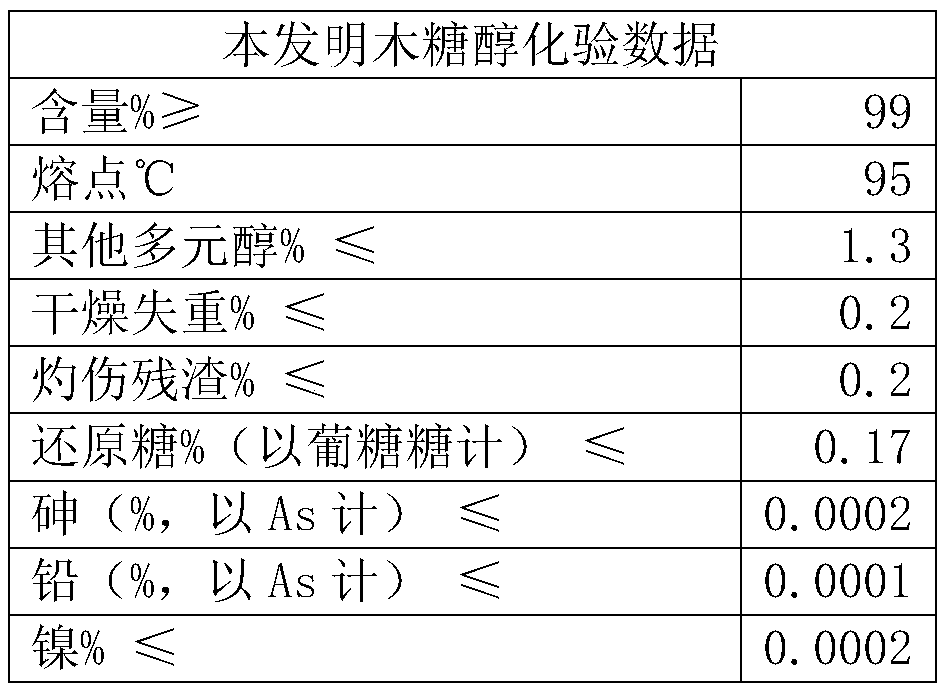A method for producing xylitol using hemicellulose extracted from regenerated cellulose fiber production or papermaking waste liquid as raw material
A technology for regenerated cellulose and hemicellulose, which is applied in xylose production, oxygen-containing functional group reduction preparation, organic chemistry, etc., can solve environmental pollution, resource waste, cost increase and other problems, and achieve pollution problems, low cost, The effect of reducing pollution
- Summary
- Abstract
- Description
- Claims
- Application Information
AI Technical Summary
Problems solved by technology
Method used
Image
Examples
Embodiment 1
[0042] A method for producing xylitol as a raw material from hemicellulose extracted from regenerated cellulose fiber production or papermaking waste liquid, comprising the following steps:
[0043] (1) collect the waste liquid that regenerated cellulose fiber produces, as hemicellulose stoste, in described hemicellulose stoste after testing, sodium hydroxide content is 0.5%, and hemicellulose content is 60g / L, also has soft water and A small amount of impurities;
[0044] (2) The hemicellulose stock solution is added in the hydrolysis tank, and sulfuric acid and an appropriate amount of water are added thereto, so that the massfraction of sulfuric acid in the hydrolyzate in the hydrolysis tank is 1.0%, and the solid content of hemicellulose and the bath ratio of the hydrolyzate are 1:10, the hemicellulose stock solution is cracked under the catalysis of sulfuric acid, the cracking temperature is 110°C, and the time is 2.5 hours, the hemicellulose in the hemicellulose stock so...
Embodiment 2
[0049] A method for producing xylitol as a raw material from hemicellulose extracted from regenerated cellulose fiber production or papermaking waste liquid, comprising the following steps:
[0050] (1) collect the waste liquid that regenerated cellulose fiber produces, as hemicellulose stoste, in described hemicellulose stoste after testing, sodium hydroxide content is 3%, and hemicellulose content is 55g / L, also has soft water and A small amount of impurities;
[0051] (2) The hemicellulose stock solution is added in the hydrolysis tank, and sulfuric acid and an appropriate amount of water are added thereto, so that the massfraction of sulfuric acid in the hydrolyzate in the hydrolysis tank is 2.0%, and the hemicellulose solid content and the bath ratio of the hydrolyzate are 1:8, the hemicellulose stock solution is cracked under the catalysis of sulfuric acid, the cracking temperature is 120°C, and the time is 1 hour, the hemicellulose in the hemicellulose stock solution co...
Embodiment 3
[0056] A method for producing xylitol as a raw material from hemicellulose extracted from regenerated cellulose fiber production or papermaking waste liquid, comprising the following steps:
[0057] (1) collect the waste liquid that regenerated cellulose fiber produces, as hemicellulose stock solution, in described hemicellulose stock solution after testing, sodium hydroxide content is 1.2%, and hemicellulose content is 57g / L, also has soft water and A small amount of impurities;
[0058] (2) The hemicellulose stock solution is added in the hydrolysis tank, and sulfuric acid and an appropriate amount of water are added thereto, so that the massfraction of sulfuric acid in the hydrolyzate in the hydrolysis tank is 1.3%, and the hemicellulose solid content and the bath ratio of the hydrolyzate are 1:9, the hemicellulose stock solution is cracked under the catalysis of sulfuric acid, the cracking temperature is 115°C, and the time is 2 hours, the hemicellulose in the hemicellulos...
PUM
 Login to View More
Login to View More Abstract
Description
Claims
Application Information
 Login to View More
Login to View More - R&D
- Intellectual Property
- Life Sciences
- Materials
- Tech Scout
- Unparalleled Data Quality
- Higher Quality Content
- 60% Fewer Hallucinations
Browse by: Latest US Patents, China's latest patents, Technical Efficacy Thesaurus, Application Domain, Technology Topic, Popular Technical Reports.
© 2025 PatSnap. All rights reserved.Legal|Privacy policy|Modern Slavery Act Transparency Statement|Sitemap|About US| Contact US: help@patsnap.com


